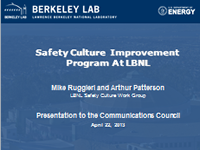When Anna Javier walked in to her battery research lab in Building 62 last fall, she was startled by the condition of the package delivered just inside the door. “It looked,” she recalls, “like a truck had run over it.” She also knew the chemical inside that package, sodium ethoxide, to be a flammable solid: Expose it to enough moisture in the air, and it will generate flammable gas. Quickly, she picked up the crushed cardboard box and placed it inside her laboratory’s fume hood, about five feet away. When Javier opened up the box, she found nestled in the inert packaging material a metal container meant to protect the glass bottle of sodium ethoxide inside. But the container was almost as badly damaged as the cardboard box, and the 10-inch bottle itself had apparently cracked. She cleared out any flammable materials nearby and contacted her safety manager Ron Scholtz. Although the package and its contents were now stored safely in the fume hood, a fire truck and a hazmat team were dispatched to assess the risk. The entire package was placed in a containment canister and taken to the hazardous waste disposal site.
A postdoc who is conducting research on block co-polymer materials for advanced batteries, Javier is accustomed to handling packages of chemicals, and her prompt action to isolate the damaged box assured there would be no further problems. So she was surprised to learn she was being lauded for her work with a Safety Spot Award. “I just did what I was supposed to do,” she says. “This was a highly corrosive chemical. If that package was more open than it was, the delivery people could have been exposed to it.” Javier’s conduct is being recognized, however, precisely because she “did what she was supposed to do.” Her actions were cited for exemplifying how safety awareness and quick thinking are integral to work in a scientific laboratory.
The incident was reviewed in group meetings. “We identified some weaknesses so we can improve our procedures,’’ says Scholtz. One lesson learned from the case was to make sure that Transportation Services personnel know that packages should be inspected for signs of damage at the loading dock. They should be reported to a safety manager and not be delivered if signs of damage are found. The incident also presented an opportunity to make sure Lab personnel are aware of other procedures meant to keep deliveries safe:
- Make sure hazardous materials are delivered directly to a laboratory, not to an office. The electronic ordering system automatically writes-in a delivery address, which should always be checked and, if necessary, changed to that of a lab location.
- Do not store packages of hazardous materials in offices or hallways.
- Inspect all delivered boxes for damage before opening. Packages with obvious damage should be placed unopened in a fume hood and reported to a lab manager.
- Wear chemical gloves, a lab coat, and safety glasses before opening chemical packages.
- Open chemical packages, whenever possible, in a fume hood with the exhaust fan on.
- Open chemical packages carefully, watching for leaks, loose caps, or broken glass.
Stop and immediately call x6999 to report any unusual problems when opening a package. Then notify a supervisor.

